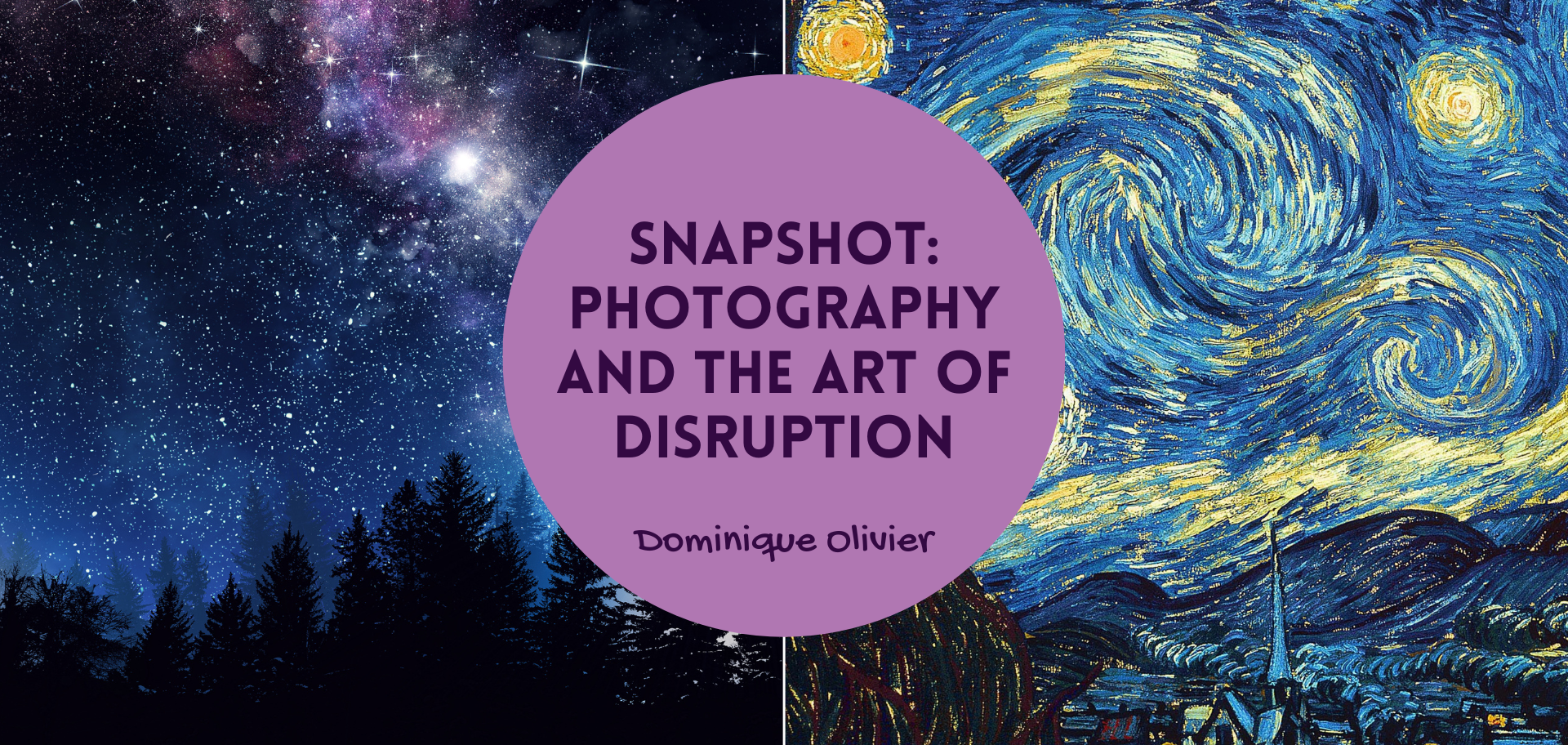Before the 1840s, visual artists had a complete monopoly on the business of making pictures. Then the camera was invented, and the world as we knew it was turned on its head. Back then, it was called the death of art. Today, we know it was really a rebirth.
Have you ever gone on a Tinder date with someone who looked nothing like the pictures on their profile? If so, you might have a bit of sympathy for Henry VIII, who is reported to have grumbled “She is nothing so fair as she hath been reported” when he met his fourth wife, Anne of Cleves, for the first time in 1539.
You see, poor Henry had been led astray by an over-diligent artist’s hand when he became engaged to Anne. Having never met her in person (he was in England at the time and she was in Germany), the only way to know what she looked like was to study a portrait of her that had been painted by Hans Holbein the Younger. The calm, pale visage depicted in the portrait was apparently a far cry from the face that Henry saw for the first time when Anne arrived in England. Legend has it that he was so incensed by the artist’s deception that he tried to stop the marriage, but political ties with Germany took precedence. The wedding took place, but the marriage was annulled just six months later – unconsummated.
As citizens of the modern age (who carry powerful cameras around in our smartphones as standard), it seems ludicrous to imagine a time in the world where the only way to know what someone looked like was to rely on an artist’s depiction. To this day, we don’t know what it was about Anne’s looks that upset Henry so much. All we have of her are portraits and Henry’s scornful comments.
The day the art world stood still
In 1839, Louis Daguerre created the first successful photographic process, called the daguerreotype, which allowed him to use light to capture an image on silver-coated copper plates. Just three years later, the first professional photography studios started to appear in Europe, using technology that condensed Daguerre’s thirty-minute-long photographic process into twenty seconds.
In 1884, George Eastman developed photosensitive film, eliminating the need for photographers to carry around plates and toxic chemicals. Four years later, Eastman’s Kodak camera went on the market, taking photography out of the hands of professionals and making it accessible to the man on the street. By 1901, every person who could afford a Kodak Brownie camera could photograph whatever they wanted.
Business owners will no doubt read this little summary of the history of photography and shake their heads in sympathy. Regardless of your industry, disruption comes at you fast. In the span of just one lifetime, photography evolved from scene fiction to everyday fact.
Rage against the machine
As you can rightly imagine, no-one was more upset by the invention of photography than the great painters of the 19th century.
From the earliest cave drawings to the most magnificent masterpieces of the Renaissance, art had always been used as a tool to copy what the human eye could see. The job of the artist was to create a believable replica of an object, landscape or person, and the more accurate the depiction, the better (just ask Henry VIII). Artists spent centuries developing techniques, materials and colours that would allow them to capture life by the work of their own hands. The most successful artists of each era had throngs of adoring patrons who considered their talents practically godlike and were willing to pay exorbitant prices for their works.
And then along comes Louis Daguerre with a mechanism that can capture an exact copy of anything in the world in a fraction of the time or effort that it took to create a painting. Democracy was coming to overthrow the monarchy of the art world, and the royals in charge were not impressed.
Disruption invites invention
When Daguerre demonstrated his new process for the French Academy in August 1840, Paul Delaroche, the celebrated history painter, proclaimed: “From today, painting is dead!”
In some ways, he was right. Art’s function as a way of illustrating the world around us was rendered moot from the moment that the first photograph was taken. But did that mean that it had no functions left at all?
While there was initial hostility and derision from artists, once emotions cooled down, many viewed photography as a tool that could be used to enhance and elevate their art. Of course there were those hardheaded individuals who derided the invention of the camera and stuck to their painterly guns in the vague hope that photography was a fad and that their patrons would return to them eventually. For the most part, they have been written out of history, left behind when the curve of invention rolled past them.
More flexible artists saw the photograph as a way to expand upon the shadow boxes that they had been using for hundreds of years prior. Since one of the greatest challenges of painting from life is translating a three-dimensional object onto a two-dimensional surface, the work of the camera in creating a two-dimensional reference image that an artist could work from allowed them to render scenes and figures with a greater degree of accuracy than ever before.
Others questioned why accuracy in painting was needed at all. If the work of the camera was satisfying the need for images that looked exactly like what they depicted, then what else was left for an image to do? An artistic movement called Impressionism answered this question by shifting focus from everything that a camera could capture to everything that it couldn’t. Fleeting moments of light and shadow, movement and emotion became their subject matter.
One indelible impression
Impressionist painters such as Claude Monet, Pierre-Auguste Renoir and Edgar Degas moved away from detailed, realistic depictions and instead embraced a more subjective and interpretative approach. Their works often featured loose brushstrokes, vibrant colors, and a focus on the atmosphere and mood rather than precise representation. By deliberately blurring the lines and creating a sense of ambiguity, they aimed to convey the immediacy and evanescence of the scenes they painted.
Impressionism challenged the traditional purpose of art by suggesting that an image’s value lay not in its faithfulness to reality but in its ability to evoke emotion, capture the essence of a moment, and provide a unique perspective that transcended mere replication.
The movement marked a significant shift in artistic philosophy, encouraging artists to explore the boundaries of perception and redefine the purpose of visual representation. In the wake of Impressionism, less figurative forms of art followed and flourished: Abstraction illustrated how much we could interpret from colour and shape alone, while Surrealism illustrated our wildest and most incoherent dreams.
If the Impressionists hadn’t led the charge and innovated their way out of disruption, it’s very possible that Paul Delaroche’s exclamation about the death of art would ring true. Fortunately, all artists are essentially self-employed entrepreneurs, which means that they have always had the tools to problem-solve their way out of a tough spot. So instead of the death of art, the camera brought about a stunning rebirth that freed artists from the shackles of representation and allowed them to peer beneath the surface, looking deeper into the things that make us human than ever before.
How is a business like a work of art?
There are two important lessons for businesses to take out of the history of the photograph.
Firstly, disruption is inevitable. Regardless of your industry, it will find you and it will try to end you. If you deny the disruption and wait for it to blow over, you run the risk of becoming like those artists who couldn’t adapt to the use of the camera – left behind in the previous century. Expect disruption – in fact, welcome it with open arms when it comes, because disruption is the fertile soil in which innovation takes the strongest root.
Secondly, never stop adapting. Here I need to mention the original disruptor in this story, Kodak, which found itself at the crest of the wave of innovation in the early 1900s. It’s all well and good to be innovative, but you can’t be innovative once and then call it a day. The wave keeps moving forward, and if you don’t stay at that forefront, there’s a very real chance that it will roll over you. Kodak was too slow to adapt to the disruption caused by digital cameras (ironically their own invention, which they backburnered in favour of film) in the late 1990s, and as a result, they have become almost as irrelevant as the film cameras that they sell.
As AI-generated art moves from experimental joke to serious contender in the art world, I for one can’t wait to see how this generation’s artists will reshape what art is amid the disruption.
About the author:

Dominique Olivier is a fine arts graduate who recently learnt what HEPS means. Although she’s really enjoying learning about the markets, she still doesn’t regret studying art instead.
She brings her love of storytelling and trivia to Ghost Mail, with The Finance Ghost adding a sprinkling of investment knowledge to her work.
Dominique is a freelance writer at Wordy Girl Writes and can be reached on LinkedIn here.





Fascinating! Thank you. Perhaps as a teacher I should embrace AI rather than ignore it!
Hi there Mike – I’m glad you enjoyed this piece! Personally, I think the magic happens when we see AI as a productivity tool instead of a threat, the same way that the Impressionists saw opportunity in the invention of the camera. I hope you try it in your teaching practice somewhere and that it elevates what you do – after all, that’s what it was made for!
This is uncanny… My 10-year-old daughter recently inspired me to read up about Elizabeth I and her father, and the Cleves Crisis struck me as Tinderesque too! I’m very excited that you turned it into a post. As someone who owns and has used a Brownie and still stuck to film until 2011, only to succumb to my phone camera, this was a beautiful article. Keep it coming!
Hi there Ludwig,
thank you so much for this lovely comment! It does indeed seem like kismet that you and this article crossed paths. I’m glad you enjoyed it, and I hope you come back for more every week!